Strategic Planning for Electric Vehicle Adoption: A Market Analysis
VerifiedAdded on 2020/04/07
|8
|2751
|1673
AI Summary
The rapid growth of the electric vehicle (EV) market is essential for reducing carbon emissions and transitioning towards sustainable energy sources. However, several challenges impede widespread adoption, including inadequate charging infrastructure, high upfront costs, range anxiety, and consumer awareness. This assignment seeks to analyze these barriers by examining current trends in EV technology, infrastructure development, and consumer behavior patterns. By drawing on research from various studies, students will propose strategic solutions that address these issues. Potential strategies may include government incentives for EV purchases, investments in charging station networks, public education campaigns, and technological advancements aimed at reducing costs and increasing vehicle range. The goal is to present a comprehensive plan that could accelerate the adoption of EVs globally, contributing to environmental sustainability and energy efficiency.
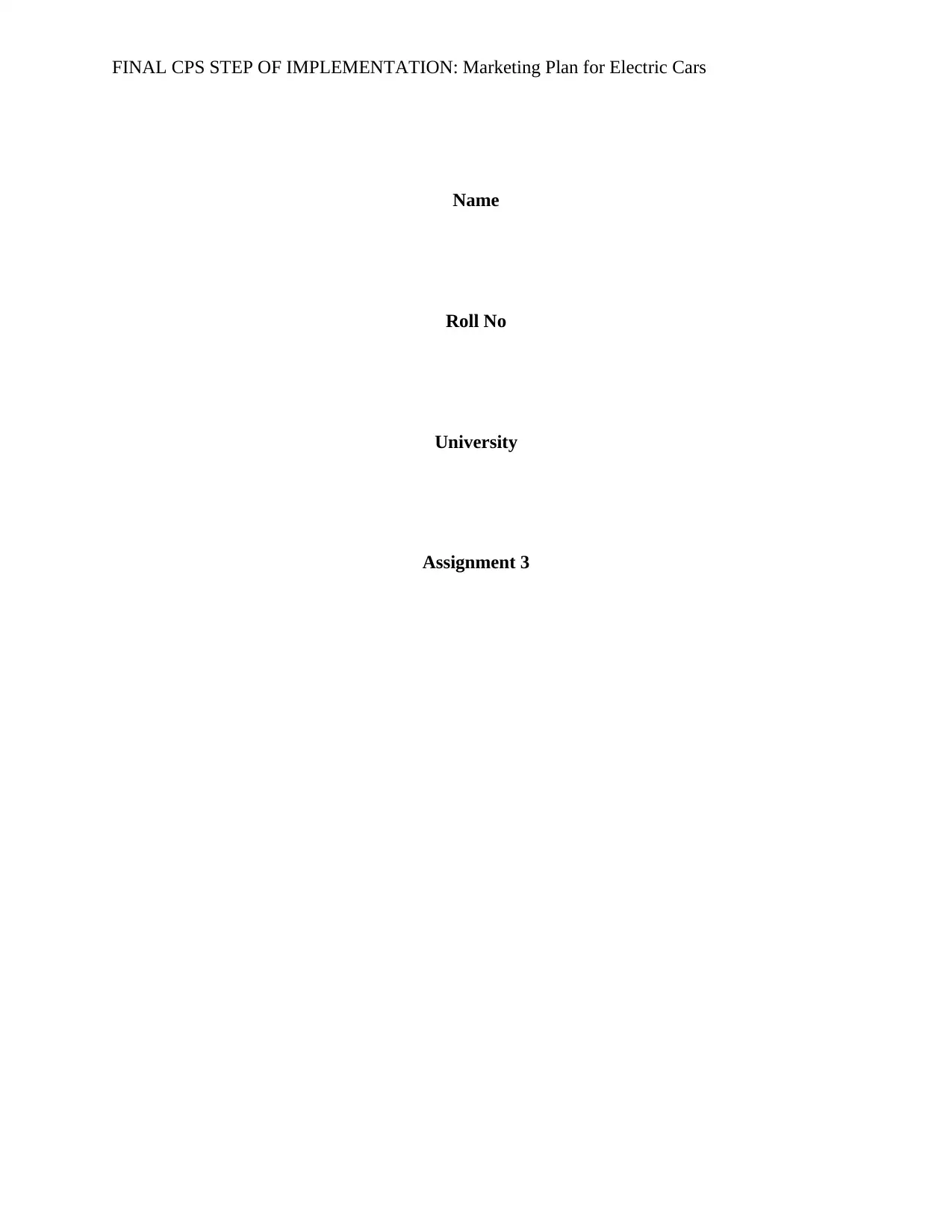
FINAL CPS STEP OF IMPLEMENTATION: Marketing Plan for Electric Cars
Name
Roll No
University
Assignment 3
Name
Roll No
University
Assignment 3
Paraphrase This Document
Need a fresh take? Get an instant paraphrase of this document with our AI Paraphraser
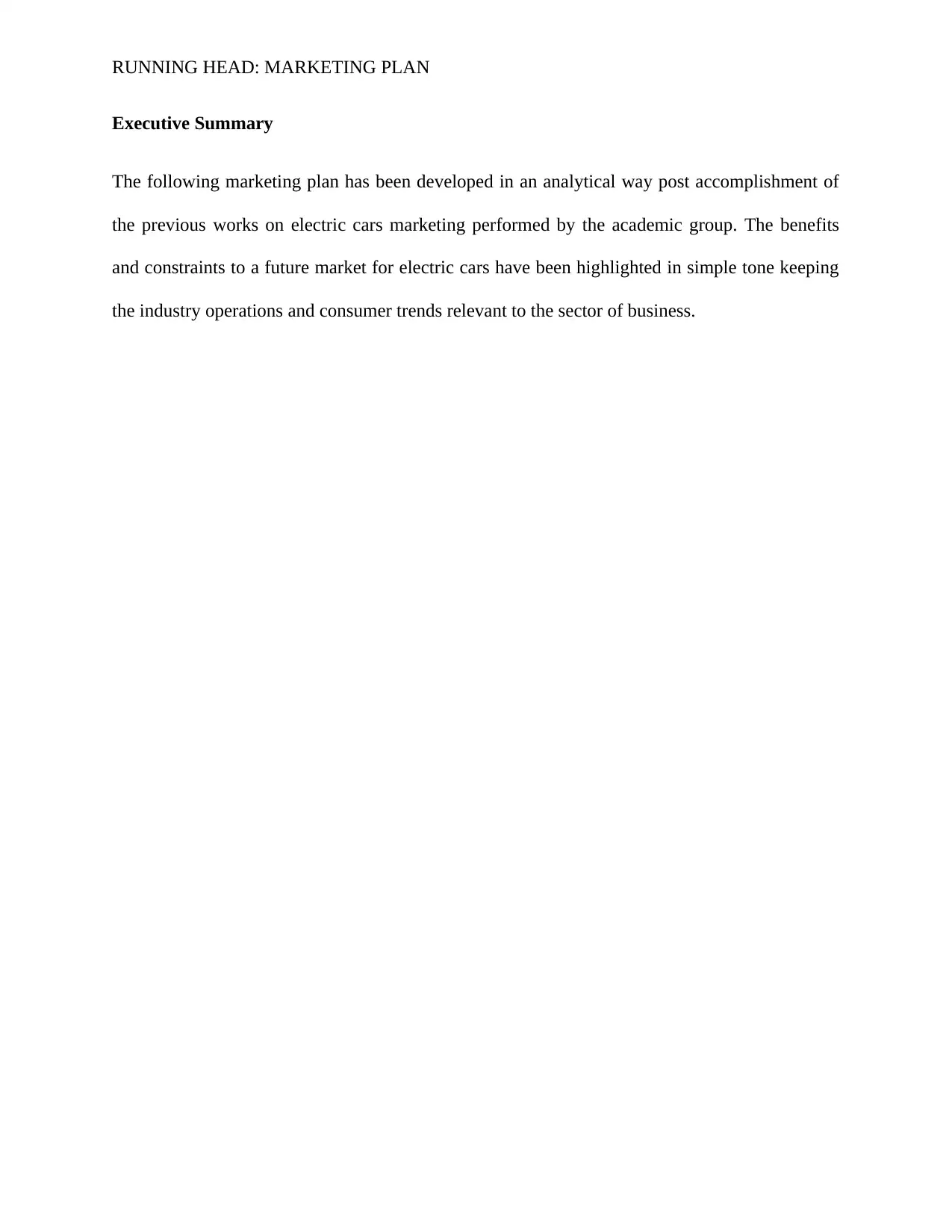
RUNNING HEAD: MARKETING PLAN
Executive Summary
The following marketing plan has been developed in an analytical way post accomplishment of
the previous works on electric cars marketing performed by the academic group. The benefits
and constraints to a future market for electric cars have been highlighted in simple tone keeping
the industry operations and consumer trends relevant to the sector of business.
Executive Summary
The following marketing plan has been developed in an analytical way post accomplishment of
the previous works on electric cars marketing performed by the academic group. The benefits
and constraints to a future market for electric cars have been highlighted in simple tone keeping
the industry operations and consumer trends relevant to the sector of business.
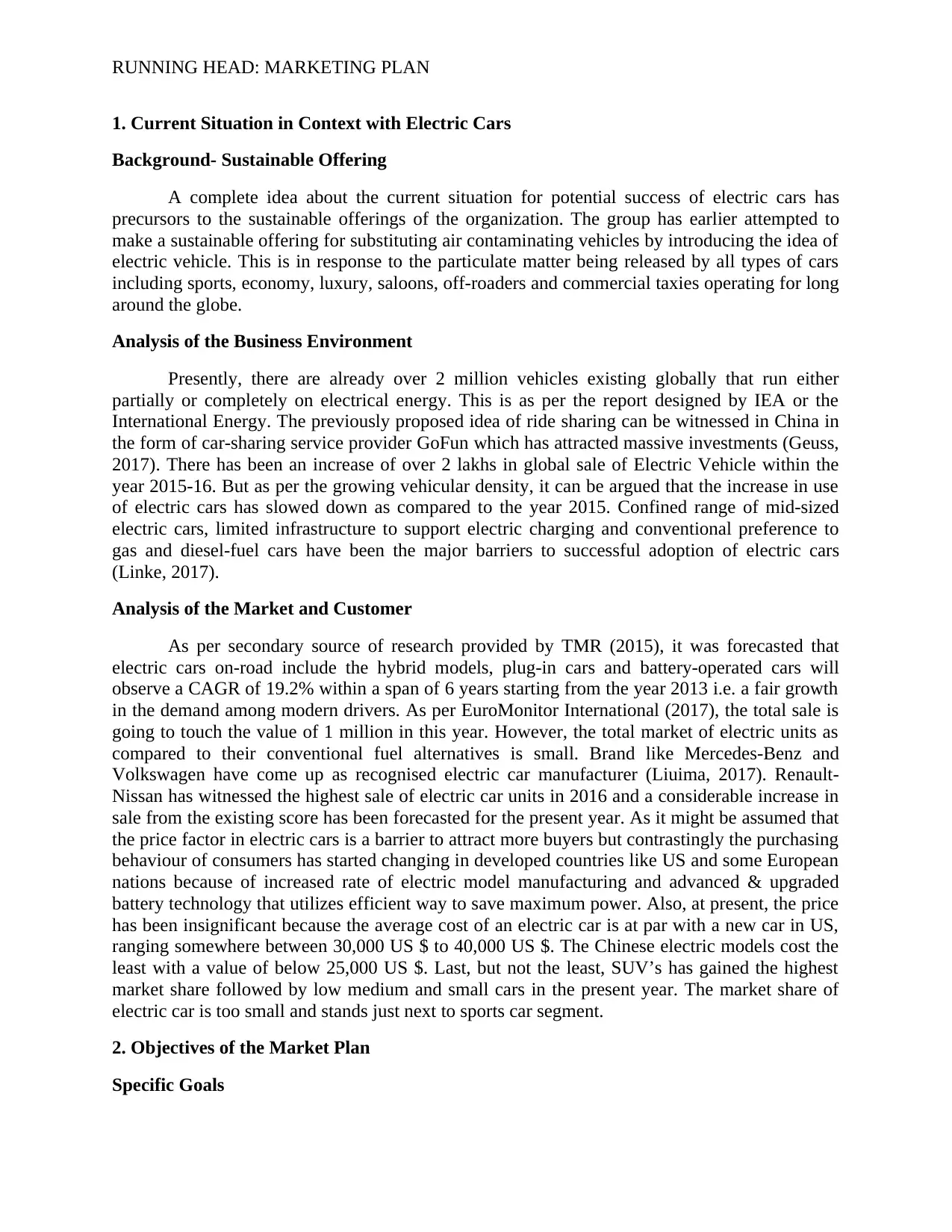
RUNNING HEAD: MARKETING PLAN
1. Current Situation in Context with Electric Cars
Background- Sustainable Offering
A complete idea about the current situation for potential success of electric cars has
precursors to the sustainable offerings of the organization. The group has earlier attempted to
make a sustainable offering for substituting air contaminating vehicles by introducing the idea of
electric vehicle. This is in response to the particulate matter being released by all types of cars
including sports, economy, luxury, saloons, off-roaders and commercial taxies operating for long
around the globe.
Analysis of the Business Environment
Presently, there are already over 2 million vehicles existing globally that run either
partially or completely on electrical energy. This is as per the report designed by IEA or the
International Energy. The previously proposed idea of ride sharing can be witnessed in China in
the form of car-sharing service provider GoFun which has attracted massive investments (Geuss,
2017). There has been an increase of over 2 lakhs in global sale of Electric Vehicle within the
year 2015-16. But as per the growing vehicular density, it can be argued that the increase in use
of electric cars has slowed down as compared to the year 2015. Confined range of mid-sized
electric cars, limited infrastructure to support electric charging and conventional preference to
gas and diesel-fuel cars have been the major barriers to successful adoption of electric cars
(Linke, 2017).
Analysis of the Market and Customer
As per secondary source of research provided by TMR (2015), it was forecasted that
electric cars on-road include the hybrid models, plug-in cars and battery-operated cars will
observe a CAGR of 19.2% within a span of 6 years starting from the year 2013 i.e. a fair growth
in the demand among modern drivers. As per EuroMonitor International (2017), the total sale is
going to touch the value of 1 million in this year. However, the total market of electric units as
compared to their conventional fuel alternatives is small. Brand like Mercedes-Benz and
Volkswagen have come up as recognised electric car manufacturer (Liuima, 2017). Renault-
Nissan has witnessed the highest sale of electric car units in 2016 and a considerable increase in
sale from the existing score has been forecasted for the present year. As it might be assumed that
the price factor in electric cars is a barrier to attract more buyers but contrastingly the purchasing
behaviour of consumers has started changing in developed countries like US and some European
nations because of increased rate of electric model manufacturing and advanced & upgraded
battery technology that utilizes efficient way to save maximum power. Also, at present, the price
has been insignificant because the average cost of an electric car is at par with a new car in US,
ranging somewhere between 30,000 US $ to 40,000 US $. The Chinese electric models cost the
least with a value of below 25,000 US $. Last, but not the least, SUV’s has gained the highest
market share followed by low medium and small cars in the present year. The market share of
electric car is too small and stands just next to sports car segment.
2. Objectives of the Market Plan
Specific Goals
1. Current Situation in Context with Electric Cars
Background- Sustainable Offering
A complete idea about the current situation for potential success of electric cars has
precursors to the sustainable offerings of the organization. The group has earlier attempted to
make a sustainable offering for substituting air contaminating vehicles by introducing the idea of
electric vehicle. This is in response to the particulate matter being released by all types of cars
including sports, economy, luxury, saloons, off-roaders and commercial taxies operating for long
around the globe.
Analysis of the Business Environment
Presently, there are already over 2 million vehicles existing globally that run either
partially or completely on electrical energy. This is as per the report designed by IEA or the
International Energy. The previously proposed idea of ride sharing can be witnessed in China in
the form of car-sharing service provider GoFun which has attracted massive investments (Geuss,
2017). There has been an increase of over 2 lakhs in global sale of Electric Vehicle within the
year 2015-16. But as per the growing vehicular density, it can be argued that the increase in use
of electric cars has slowed down as compared to the year 2015. Confined range of mid-sized
electric cars, limited infrastructure to support electric charging and conventional preference to
gas and diesel-fuel cars have been the major barriers to successful adoption of electric cars
(Linke, 2017).
Analysis of the Market and Customer
As per secondary source of research provided by TMR (2015), it was forecasted that
electric cars on-road include the hybrid models, plug-in cars and battery-operated cars will
observe a CAGR of 19.2% within a span of 6 years starting from the year 2013 i.e. a fair growth
in the demand among modern drivers. As per EuroMonitor International (2017), the total sale is
going to touch the value of 1 million in this year. However, the total market of electric units as
compared to their conventional fuel alternatives is small. Brand like Mercedes-Benz and
Volkswagen have come up as recognised electric car manufacturer (Liuima, 2017). Renault-
Nissan has witnessed the highest sale of electric car units in 2016 and a considerable increase in
sale from the existing score has been forecasted for the present year. As it might be assumed that
the price factor in electric cars is a barrier to attract more buyers but contrastingly the purchasing
behaviour of consumers has started changing in developed countries like US and some European
nations because of increased rate of electric model manufacturing and advanced & upgraded
battery technology that utilizes efficient way to save maximum power. Also, at present, the price
has been insignificant because the average cost of an electric car is at par with a new car in US,
ranging somewhere between 30,000 US $ to 40,000 US $. The Chinese electric models cost the
least with a value of below 25,000 US $. Last, but not the least, SUV’s has gained the highest
market share followed by low medium and small cars in the present year. The market share of
electric car is too small and stands just next to sports car segment.
2. Objectives of the Market Plan
Specific Goals
⊘ This is a preview!⊘
Do you want full access?
Subscribe today to unlock all pages.

Trusted by 1+ million students worldwide
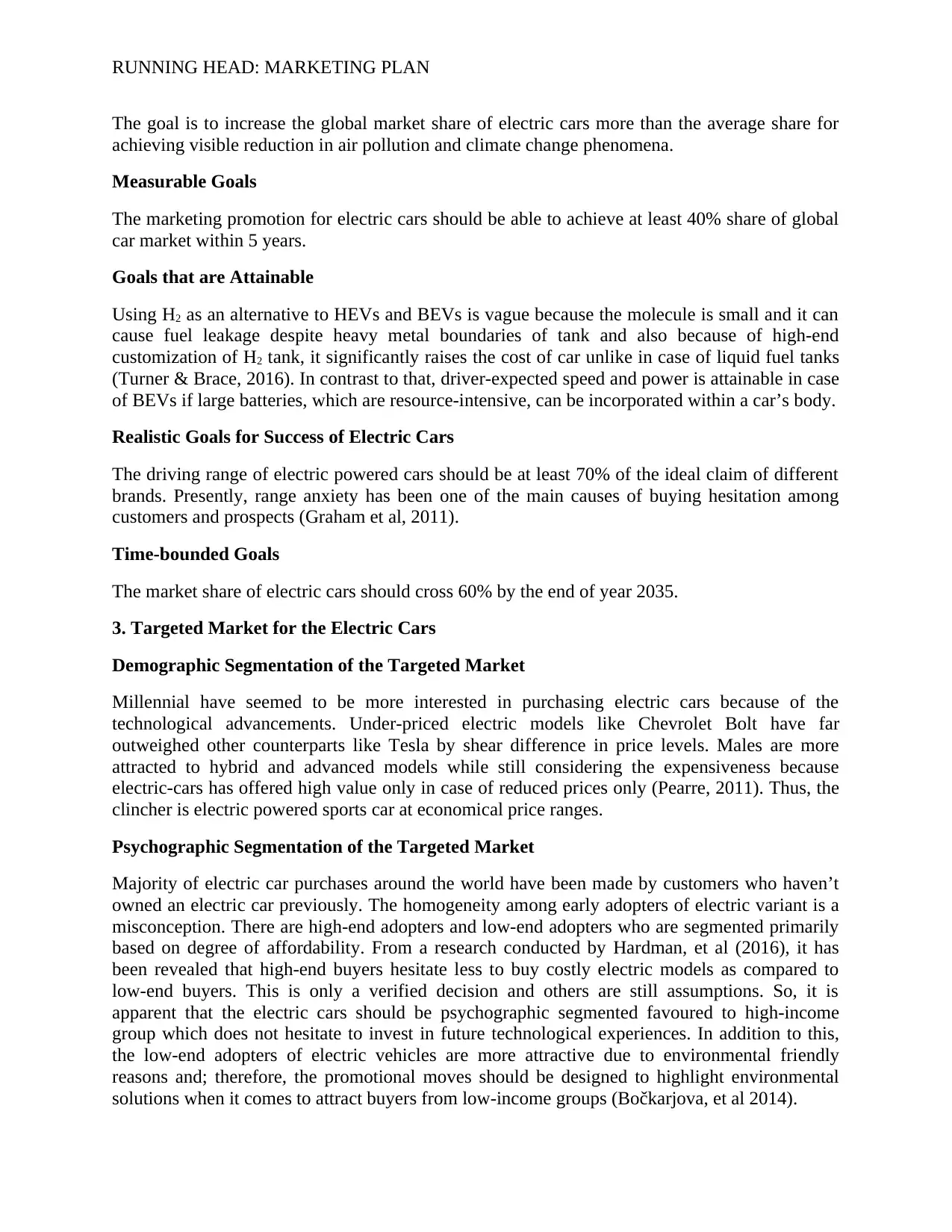
RUNNING HEAD: MARKETING PLAN
The goal is to increase the global market share of electric cars more than the average share for
achieving visible reduction in air pollution and climate change phenomena.
Measurable Goals
The marketing promotion for electric cars should be able to achieve at least 40% share of global
car market within 5 years.
Goals that are Attainable
Using H2 as an alternative to HEVs and BEVs is vague because the molecule is small and it can
cause fuel leakage despite heavy metal boundaries of tank and also because of high-end
customization of H2 tank, it significantly raises the cost of car unlike in case of liquid fuel tanks
(Turner & Brace, 2016). In contrast to that, driver-expected speed and power is attainable in case
of BEVs if large batteries, which are resource-intensive, can be incorporated within a car’s body.
Realistic Goals for Success of Electric Cars
The driving range of electric powered cars should be at least 70% of the ideal claim of different
brands. Presently, range anxiety has been one of the main causes of buying hesitation among
customers and prospects (Graham et al, 2011).
Time-bounded Goals
The market share of electric cars should cross 60% by the end of year 2035.
3. Targeted Market for the Electric Cars
Demographic Segmentation of the Targeted Market
Millennial have seemed to be more interested in purchasing electric cars because of the
technological advancements. Under-priced electric models like Chevrolet Bolt have far
outweighed other counterparts like Tesla by shear difference in price levels. Males are more
attracted to hybrid and advanced models while still considering the expensiveness because
electric-cars has offered high value only in case of reduced prices only (Pearre, 2011). Thus, the
clincher is electric powered sports car at economical price ranges.
Psychographic Segmentation of the Targeted Market
Majority of electric car purchases around the world have been made by customers who haven’t
owned an electric car previously. The homogeneity among early adopters of electric variant is a
misconception. There are high-end adopters and low-end adopters who are segmented primarily
based on degree of affordability. From a research conducted by Hardman, et al (2016), it has
been revealed that high-end buyers hesitate less to buy costly electric models as compared to
low-end buyers. This is only a verified decision and others are still assumptions. So, it is
apparent that the electric cars should be psychographic segmented favoured to high-income
group which does not hesitate to invest in future technological experiences. In addition to this,
the low-end adopters of electric vehicles are more attractive due to environmental friendly
reasons and; therefore, the promotional moves should be designed to highlight environmental
solutions when it comes to attract buyers from low-income groups (Bočkarjova, et al 2014).
The goal is to increase the global market share of electric cars more than the average share for
achieving visible reduction in air pollution and climate change phenomena.
Measurable Goals
The marketing promotion for electric cars should be able to achieve at least 40% share of global
car market within 5 years.
Goals that are Attainable
Using H2 as an alternative to HEVs and BEVs is vague because the molecule is small and it can
cause fuel leakage despite heavy metal boundaries of tank and also because of high-end
customization of H2 tank, it significantly raises the cost of car unlike in case of liquid fuel tanks
(Turner & Brace, 2016). In contrast to that, driver-expected speed and power is attainable in case
of BEVs if large batteries, which are resource-intensive, can be incorporated within a car’s body.
Realistic Goals for Success of Electric Cars
The driving range of electric powered cars should be at least 70% of the ideal claim of different
brands. Presently, range anxiety has been one of the main causes of buying hesitation among
customers and prospects (Graham et al, 2011).
Time-bounded Goals
The market share of electric cars should cross 60% by the end of year 2035.
3. Targeted Market for the Electric Cars
Demographic Segmentation of the Targeted Market
Millennial have seemed to be more interested in purchasing electric cars because of the
technological advancements. Under-priced electric models like Chevrolet Bolt have far
outweighed other counterparts like Tesla by shear difference in price levels. Males are more
attracted to hybrid and advanced models while still considering the expensiveness because
electric-cars has offered high value only in case of reduced prices only (Pearre, 2011). Thus, the
clincher is electric powered sports car at economical price ranges.
Psychographic Segmentation of the Targeted Market
Majority of electric car purchases around the world have been made by customers who haven’t
owned an electric car previously. The homogeneity among early adopters of electric variant is a
misconception. There are high-end adopters and low-end adopters who are segmented primarily
based on degree of affordability. From a research conducted by Hardman, et al (2016), it has
been revealed that high-end buyers hesitate less to buy costly electric models as compared to
low-end buyers. This is only a verified decision and others are still assumptions. So, it is
apparent that the electric cars should be psychographic segmented favoured to high-income
group which does not hesitate to invest in future technological experiences. In addition to this,
the low-end adopters of electric vehicles are more attractive due to environmental friendly
reasons and; therefore, the promotional moves should be designed to highlight environmental
solutions when it comes to attract buyers from low-income groups (Bočkarjova, et al 2014).
Paraphrase This Document
Need a fresh take? Get an instant paraphrase of this document with our AI Paraphraser
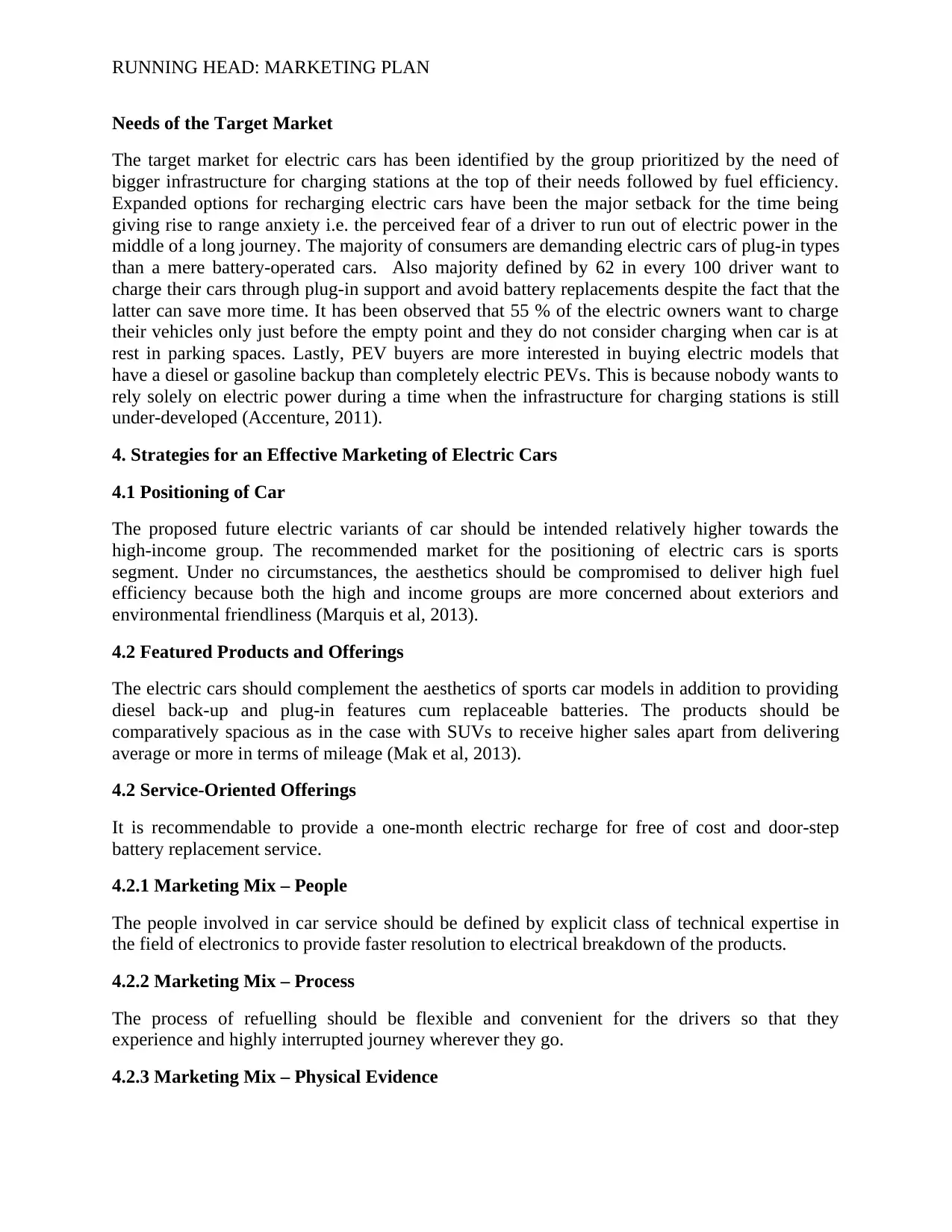
RUNNING HEAD: MARKETING PLAN
Needs of the Target Market
The target market for electric cars has been identified by the group prioritized by the need of
bigger infrastructure for charging stations at the top of their needs followed by fuel efficiency.
Expanded options for recharging electric cars have been the major setback for the time being
giving rise to range anxiety i.e. the perceived fear of a driver to run out of electric power in the
middle of a long journey. The majority of consumers are demanding electric cars of plug-in types
than a mere battery-operated cars. Also majority defined by 62 in every 100 driver want to
charge their cars through plug-in support and avoid battery replacements despite the fact that the
latter can save more time. It has been observed that 55 % of the electric owners want to charge
their vehicles only just before the empty point and they do not consider charging when car is at
rest in parking spaces. Lastly, PEV buyers are more interested in buying electric models that
have a diesel or gasoline backup than completely electric PEVs. This is because nobody wants to
rely solely on electric power during a time when the infrastructure for charging stations is still
under-developed (Accenture, 2011).
4. Strategies for an Effective Marketing of Electric Cars
4.1 Positioning of Car
The proposed future electric variants of car should be intended relatively higher towards the
high-income group. The recommended market for the positioning of electric cars is sports
segment. Under no circumstances, the aesthetics should be compromised to deliver high fuel
efficiency because both the high and income groups are more concerned about exteriors and
environmental friendliness (Marquis et al, 2013).
4.2 Featured Products and Offerings
The electric cars should complement the aesthetics of sports car models in addition to providing
diesel back-up and plug-in features cum replaceable batteries. The products should be
comparatively spacious as in the case with SUVs to receive higher sales apart from delivering
average or more in terms of mileage (Mak et al, 2013).
4.2 Service-Oriented Offerings
It is recommendable to provide a one-month electric recharge for free of cost and door-step
battery replacement service.
4.2.1 Marketing Mix – People
The people involved in car service should be defined by explicit class of technical expertise in
the field of electronics to provide faster resolution to electrical breakdown of the products.
4.2.2 Marketing Mix – Process
The process of refuelling should be flexible and convenient for the drivers so that they
experience and highly interrupted journey wherever they go.
4.2.3 Marketing Mix – Physical Evidence
Needs of the Target Market
The target market for electric cars has been identified by the group prioritized by the need of
bigger infrastructure for charging stations at the top of their needs followed by fuel efficiency.
Expanded options for recharging electric cars have been the major setback for the time being
giving rise to range anxiety i.e. the perceived fear of a driver to run out of electric power in the
middle of a long journey. The majority of consumers are demanding electric cars of plug-in types
than a mere battery-operated cars. Also majority defined by 62 in every 100 driver want to
charge their cars through plug-in support and avoid battery replacements despite the fact that the
latter can save more time. It has been observed that 55 % of the electric owners want to charge
their vehicles only just before the empty point and they do not consider charging when car is at
rest in parking spaces. Lastly, PEV buyers are more interested in buying electric models that
have a diesel or gasoline backup than completely electric PEVs. This is because nobody wants to
rely solely on electric power during a time when the infrastructure for charging stations is still
under-developed (Accenture, 2011).
4. Strategies for an Effective Marketing of Electric Cars
4.1 Positioning of Car
The proposed future electric variants of car should be intended relatively higher towards the
high-income group. The recommended market for the positioning of electric cars is sports
segment. Under no circumstances, the aesthetics should be compromised to deliver high fuel
efficiency because both the high and income groups are more concerned about exteriors and
environmental friendliness (Marquis et al, 2013).
4.2 Featured Products and Offerings
The electric cars should complement the aesthetics of sports car models in addition to providing
diesel back-up and plug-in features cum replaceable batteries. The products should be
comparatively spacious as in the case with SUVs to receive higher sales apart from delivering
average or more in terms of mileage (Mak et al, 2013).
4.2 Service-Oriented Offerings
It is recommendable to provide a one-month electric recharge for free of cost and door-step
battery replacement service.
4.2.1 Marketing Mix – People
The people involved in car service should be defined by explicit class of technical expertise in
the field of electronics to provide faster resolution to electrical breakdown of the products.
4.2.2 Marketing Mix – Process
The process of refuelling should be flexible and convenient for the drivers so that they
experience and highly interrupted journey wherever they go.
4.2.3 Marketing Mix – Physical Evidence
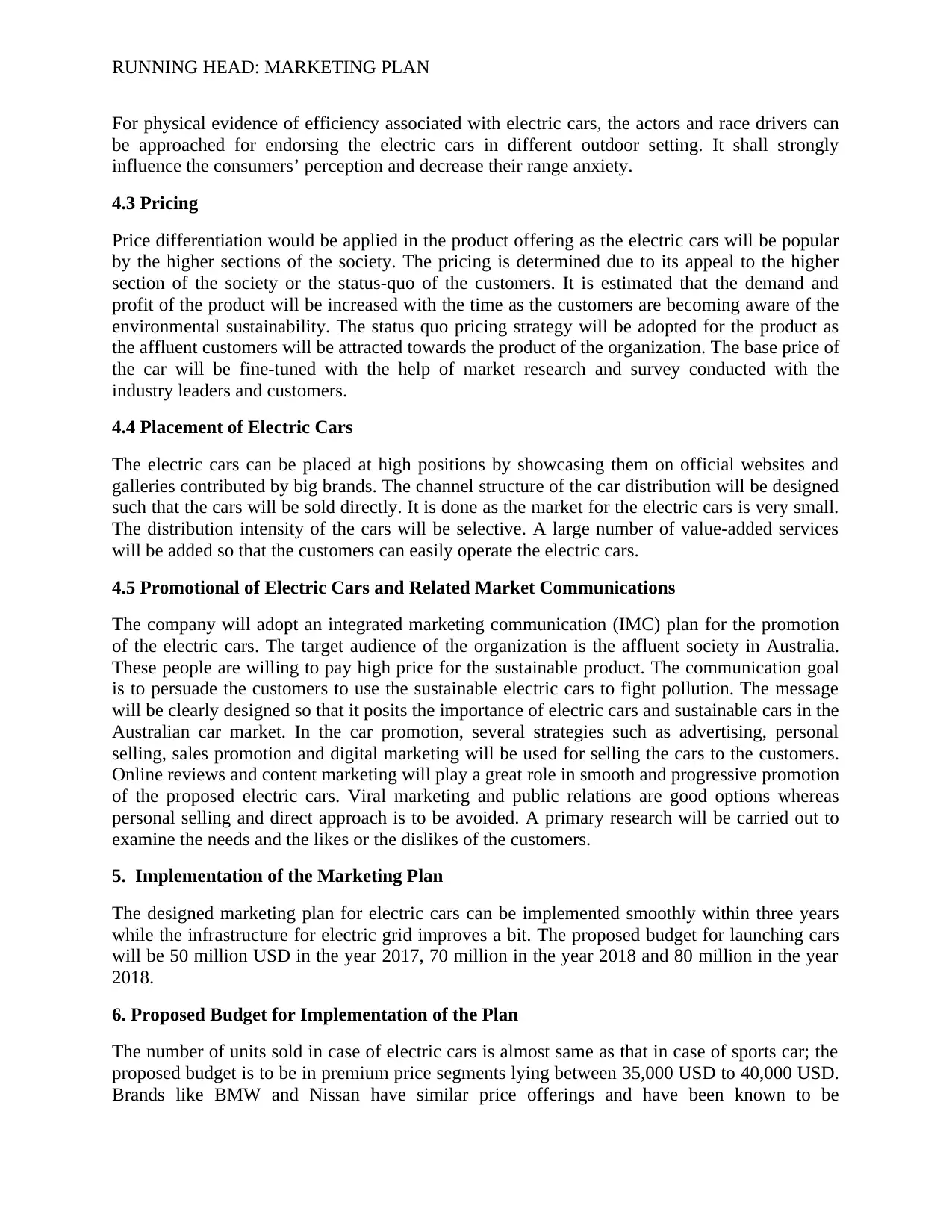
RUNNING HEAD: MARKETING PLAN
For physical evidence of efficiency associated with electric cars, the actors and race drivers can
be approached for endorsing the electric cars in different outdoor setting. It shall strongly
influence the consumers’ perception and decrease their range anxiety.
4.3 Pricing
Price differentiation would be applied in the product offering as the electric cars will be popular
by the higher sections of the society. The pricing is determined due to its appeal to the higher
section of the society or the status-quo of the customers. It is estimated that the demand and
profit of the product will be increased with the time as the customers are becoming aware of the
environmental sustainability. The status quo pricing strategy will be adopted for the product as
the affluent customers will be attracted towards the product of the organization. The base price of
the car will be fine-tuned with the help of market research and survey conducted with the
industry leaders and customers.
4.4 Placement of Electric Cars
The electric cars can be placed at high positions by showcasing them on official websites and
galleries contributed by big brands. The channel structure of the car distribution will be designed
such that the cars will be sold directly. It is done as the market for the electric cars is very small.
The distribution intensity of the cars will be selective. A large number of value-added services
will be added so that the customers can easily operate the electric cars.
4.5 Promotional of Electric Cars and Related Market Communications
The company will adopt an integrated marketing communication (IMC) plan for the promotion
of the electric cars. The target audience of the organization is the affluent society in Australia.
These people are willing to pay high price for the sustainable product. The communication goal
is to persuade the customers to use the sustainable electric cars to fight pollution. The message
will be clearly designed so that it posits the importance of electric cars and sustainable cars in the
Australian car market. In the car promotion, several strategies such as advertising, personal
selling, sales promotion and digital marketing will be used for selling the cars to the customers.
Online reviews and content marketing will play a great role in smooth and progressive promotion
of the proposed electric cars. Viral marketing and public relations are good options whereas
personal selling and direct approach is to be avoided. A primary research will be carried out to
examine the needs and the likes or the dislikes of the customers.
5. Implementation of the Marketing Plan
The designed marketing plan for electric cars can be implemented smoothly within three years
while the infrastructure for electric grid improves a bit. The proposed budget for launching cars
will be 50 million USD in the year 2017, 70 million in the year 2018 and 80 million in the year
2018.
6. Proposed Budget for Implementation of the Plan
The number of units sold in case of electric cars is almost same as that in case of sports car; the
proposed budget is to be in premium price segments lying between 35,000 USD to 40,000 USD.
Brands like BMW and Nissan have similar price offerings and have been known to be
For physical evidence of efficiency associated with electric cars, the actors and race drivers can
be approached for endorsing the electric cars in different outdoor setting. It shall strongly
influence the consumers’ perception and decrease their range anxiety.
4.3 Pricing
Price differentiation would be applied in the product offering as the electric cars will be popular
by the higher sections of the society. The pricing is determined due to its appeal to the higher
section of the society or the status-quo of the customers. It is estimated that the demand and
profit of the product will be increased with the time as the customers are becoming aware of the
environmental sustainability. The status quo pricing strategy will be adopted for the product as
the affluent customers will be attracted towards the product of the organization. The base price of
the car will be fine-tuned with the help of market research and survey conducted with the
industry leaders and customers.
4.4 Placement of Electric Cars
The electric cars can be placed at high positions by showcasing them on official websites and
galleries contributed by big brands. The channel structure of the car distribution will be designed
such that the cars will be sold directly. It is done as the market for the electric cars is very small.
The distribution intensity of the cars will be selective. A large number of value-added services
will be added so that the customers can easily operate the electric cars.
4.5 Promotional of Electric Cars and Related Market Communications
The company will adopt an integrated marketing communication (IMC) plan for the promotion
of the electric cars. The target audience of the organization is the affluent society in Australia.
These people are willing to pay high price for the sustainable product. The communication goal
is to persuade the customers to use the sustainable electric cars to fight pollution. The message
will be clearly designed so that it posits the importance of electric cars and sustainable cars in the
Australian car market. In the car promotion, several strategies such as advertising, personal
selling, sales promotion and digital marketing will be used for selling the cars to the customers.
Online reviews and content marketing will play a great role in smooth and progressive promotion
of the proposed electric cars. Viral marketing and public relations are good options whereas
personal selling and direct approach is to be avoided. A primary research will be carried out to
examine the needs and the likes or the dislikes of the customers.
5. Implementation of the Marketing Plan
The designed marketing plan for electric cars can be implemented smoothly within three years
while the infrastructure for electric grid improves a bit. The proposed budget for launching cars
will be 50 million USD in the year 2017, 70 million in the year 2018 and 80 million in the year
2018.
6. Proposed Budget for Implementation of the Plan
The number of units sold in case of electric cars is almost same as that in case of sports car; the
proposed budget is to be in premium price segments lying between 35,000 USD to 40,000 USD.
Brands like BMW and Nissan have similar price offerings and have been known to be
⊘ This is a preview!⊘
Do you want full access?
Subscribe today to unlock all pages.

Trusted by 1+ million students worldwide
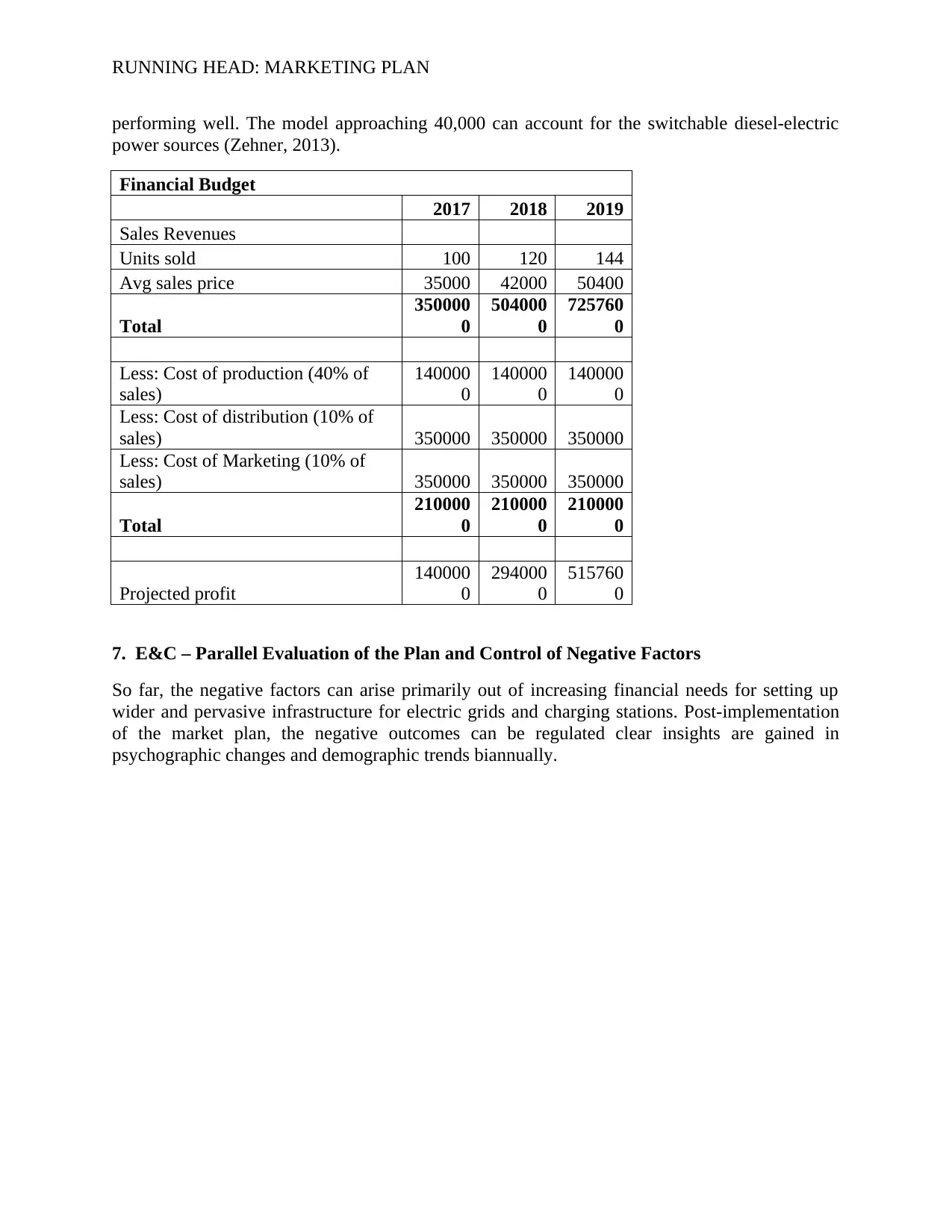
RUNNING HEAD: MARKETING PLAN
performing well. The model approaching 40,000 can account for the switchable diesel-electric
power sources (Zehner, 2013).
Financial Budget
2017 2018 2019
Sales Revenues
Units sold 100 120 144
Avg sales price 35000 42000 50400
Total
350000
0
504000
0
725760
0
Less: Cost of production (40% of
sales)
140000
0
140000
0
140000
0
Less: Cost of distribution (10% of
sales) 350000 350000 350000
Less: Cost of Marketing (10% of
sales) 350000 350000 350000
Total
210000
0
210000
0
210000
0
Projected profit
140000
0
294000
0
515760
0
7. E&C – Parallel Evaluation of the Plan and Control of Negative Factors
So far, the negative factors can arise primarily out of increasing financial needs for setting up
wider and pervasive infrastructure for electric grids and charging stations. Post-implementation
of the market plan, the negative outcomes can be regulated clear insights are gained in
psychographic changes and demographic trends biannually.
performing well. The model approaching 40,000 can account for the switchable diesel-electric
power sources (Zehner, 2013).
Financial Budget
2017 2018 2019
Sales Revenues
Units sold 100 120 144
Avg sales price 35000 42000 50400
Total
350000
0
504000
0
725760
0
Less: Cost of production (40% of
sales)
140000
0
140000
0
140000
0
Less: Cost of distribution (10% of
sales) 350000 350000 350000
Less: Cost of Marketing (10% of
sales) 350000 350000 350000
Total
210000
0
210000
0
210000
0
Projected profit
140000
0
294000
0
515760
0
7. E&C – Parallel Evaluation of the Plan and Control of Negative Factors
So far, the negative factors can arise primarily out of increasing financial needs for setting up
wider and pervasive infrastructure for electric grids and charging stations. Post-implementation
of the market plan, the negative outcomes can be regulated clear insights are gained in
psychographic changes and demographic trends biannually.
Paraphrase This Document
Need a fresh take? Get an instant paraphrase of this document with our AI Paraphraser
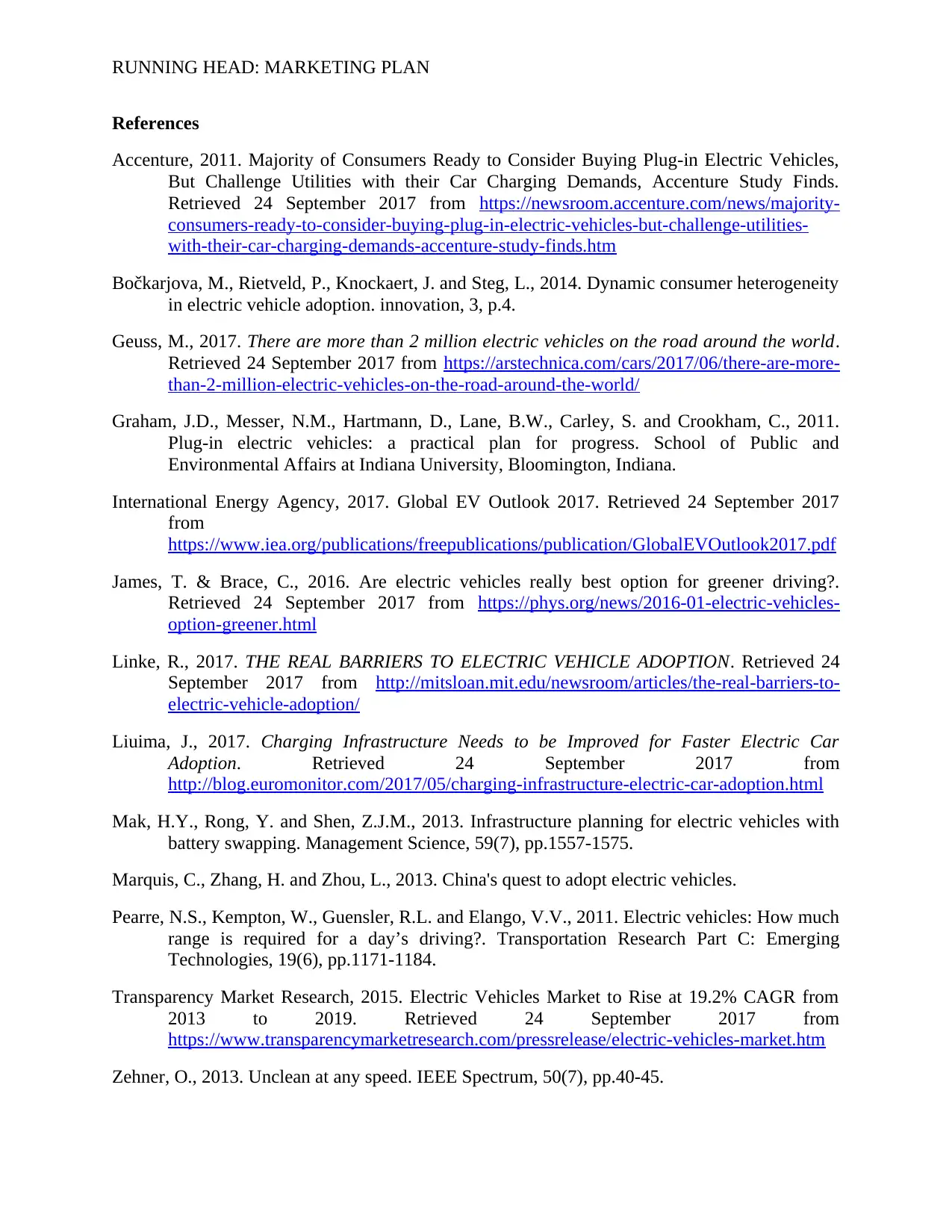
RUNNING HEAD: MARKETING PLAN
References
Accenture, 2011. Majority of Consumers Ready to Consider Buying Plug-in Electric Vehicles,
But Challenge Utilities with their Car Charging Demands, Accenture Study Finds.
Retrieved 24 September 2017 from https://newsroom.accenture.com/news/majority-
consumers-ready-to-consider-buying-plug-in-electric-vehicles-but-challenge-utilities-
with-their-car-charging-demands-accenture-study-finds.htm
Bočkarjova, M., Rietveld, P., Knockaert, J. and Steg, L., 2014. Dynamic consumer heterogeneity
in electric vehicle adoption. innovation, 3, p.4.
Geuss, M., 2017. There are more than 2 million electric vehicles on the road around the world.
Retrieved 24 September 2017 from https://arstechnica.com/cars/2017/06/there-are-more-
than-2-million-electric-vehicles-on-the-road-around-the-world/
Graham, J.D., Messer, N.M., Hartmann, D., Lane, B.W., Carley, S. and Crookham, C., 2011.
Plug-in electric vehicles: a practical plan for progress. School of Public and
Environmental Affairs at Indiana University, Bloomington, Indiana.
International Energy Agency, 2017. Global EV Outlook 2017. Retrieved 24 September 2017
from
https://www.iea.org/publications/freepublications/publication/GlobalEVOutlook2017.pdf
James, T. & Brace, C., 2016. Are electric vehicles really best option for greener driving?.
Retrieved 24 September 2017 from https://phys.org/news/2016-01-electric-vehicles-
option-greener.html
Linke, R., 2017. THE REAL BARRIERS TO ELECTRIC VEHICLE ADOPTION. Retrieved 24
September 2017 from http://mitsloan.mit.edu/newsroom/articles/the-real-barriers-to-
electric-vehicle-adoption/
Liuima, J., 2017. Charging Infrastructure Needs to be Improved for Faster Electric Car
Adoption. Retrieved 24 September 2017 from
http://blog.euromonitor.com/2017/05/charging-infrastructure-electric-car-adoption.html
Mak, H.Y., Rong, Y. and Shen, Z.J.M., 2013. Infrastructure planning for electric vehicles with
battery swapping. Management Science, 59(7), pp.1557-1575.
Marquis, C., Zhang, H. and Zhou, L., 2013. China's quest to adopt electric vehicles.
Pearre, N.S., Kempton, W., Guensler, R.L. and Elango, V.V., 2011. Electric vehicles: How much
range is required for a day’s driving?. Transportation Research Part C: Emerging
Technologies, 19(6), pp.1171-1184.
Transparency Market Research, 2015. Electric Vehicles Market to Rise at 19.2% CAGR from
2013 to 2019. Retrieved 24 September 2017 from
https://www.transparencymarketresearch.com/pressrelease/electric-vehicles-market.htm
Zehner, O., 2013. Unclean at any speed. IEEE Spectrum, 50(7), pp.40-45.
References
Accenture, 2011. Majority of Consumers Ready to Consider Buying Plug-in Electric Vehicles,
But Challenge Utilities with their Car Charging Demands, Accenture Study Finds.
Retrieved 24 September 2017 from https://newsroom.accenture.com/news/majority-
consumers-ready-to-consider-buying-plug-in-electric-vehicles-but-challenge-utilities-
with-their-car-charging-demands-accenture-study-finds.htm
Bočkarjova, M., Rietveld, P., Knockaert, J. and Steg, L., 2014. Dynamic consumer heterogeneity
in electric vehicle adoption. innovation, 3, p.4.
Geuss, M., 2017. There are more than 2 million electric vehicles on the road around the world.
Retrieved 24 September 2017 from https://arstechnica.com/cars/2017/06/there-are-more-
than-2-million-electric-vehicles-on-the-road-around-the-world/
Graham, J.D., Messer, N.M., Hartmann, D., Lane, B.W., Carley, S. and Crookham, C., 2011.
Plug-in electric vehicles: a practical plan for progress. School of Public and
Environmental Affairs at Indiana University, Bloomington, Indiana.
International Energy Agency, 2017. Global EV Outlook 2017. Retrieved 24 September 2017
from
https://www.iea.org/publications/freepublications/publication/GlobalEVOutlook2017.pdf
James, T. & Brace, C., 2016. Are electric vehicles really best option for greener driving?.
Retrieved 24 September 2017 from https://phys.org/news/2016-01-electric-vehicles-
option-greener.html
Linke, R., 2017. THE REAL BARRIERS TO ELECTRIC VEHICLE ADOPTION. Retrieved 24
September 2017 from http://mitsloan.mit.edu/newsroom/articles/the-real-barriers-to-
electric-vehicle-adoption/
Liuima, J., 2017. Charging Infrastructure Needs to be Improved for Faster Electric Car
Adoption. Retrieved 24 September 2017 from
http://blog.euromonitor.com/2017/05/charging-infrastructure-electric-car-adoption.html
Mak, H.Y., Rong, Y. and Shen, Z.J.M., 2013. Infrastructure planning for electric vehicles with
battery swapping. Management Science, 59(7), pp.1557-1575.
Marquis, C., Zhang, H. and Zhou, L., 2013. China's quest to adopt electric vehicles.
Pearre, N.S., Kempton, W., Guensler, R.L. and Elango, V.V., 2011. Electric vehicles: How much
range is required for a day’s driving?. Transportation Research Part C: Emerging
Technologies, 19(6), pp.1171-1184.
Transparency Market Research, 2015. Electric Vehicles Market to Rise at 19.2% CAGR from
2013 to 2019. Retrieved 24 September 2017 from
https://www.transparencymarketresearch.com/pressrelease/electric-vehicles-market.htm
Zehner, O., 2013. Unclean at any speed. IEEE Spectrum, 50(7), pp.40-45.
1 out of 8
Related Documents
Your All-in-One AI-Powered Toolkit for Academic Success.
+13062052269
info@desklib.com
Available 24*7 on WhatsApp / Email
![[object Object]](/_next/static/media/star-bottom.7253800d.svg)
Unlock your academic potential
Copyright © 2020–2025 A2Z Services. All Rights Reserved. Developed and managed by ZUCOL.




